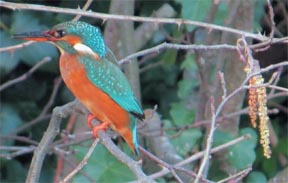|
Wildlife
Newsletter for the Township of Dalkey April 2015 - Michael Ryan |
 Male
Teal Male
Teal Photo: M.Ryan |
Our
last IWebs (Irish Wetland Birds) count for the Winter 2014/15 season
took place on a lovely mild bright Saturday morning in early March.
Alinnet was singing from atop a bush beside the Booterstown DART car
park. Male linnets had been singing for weeks before but another bird
bursting into song a few minutes later was a pleasant surprise. It was
a blackcap, the first time this year we’d heard one singing although
both a male and a female blackcap have been constant visitors to our
garden throughout the winter, feeding on fat balls, apples and occasionally
sunflower seeds. I’ve mentioned many times how lovely their song
is, earning them the name of ‘Ireland’s Nightingale’.
Within weeks Dalkey and Killiney Hills should be resounding to the sounds
of male blackcaps who have arrived from southern Europe or Africa declaring
their territory but here in Booterstown it was still only March and
almost certainly this bird wasn’t a summer migrant but a bird
that had spent the winter here and would probably soon be setting off
to summer breeding grounds. |
| Wintering
blackcaps have been trapped and, causing no discomfort to individual
birds, have had stable isotope analysis done on nail clippings and
feathers which have revealed the birds originated in areas of eastern
Europe including Germany and Poland. So our wintering blackcaps are
from there but the ones we’ll have breeding throughout summer
will have migrated back to us from further south. |
|
| Ireland
are in serious decline and many of the birds that we see in the marsh
are probably birds that are wintering here from Europe. Today would
probably be the last time we’d see any till next winter so it
was really nice to see so many in such good light. Out on the strand,
though the sea was choppy, there was real heat in the sun, so pleasant
compared to counts in cold winds and lashing rain in December and January,
even warm enough to leave off gloves. Disturbance can be a problem and
when you’re trying to count birds on the edge of the tide the
last thing you need is a dog arriving whose idea of fun is bounding
up and chasing them all as often happens, but today any of the dogs
on the strand were content to wander along beside their owner or chase
balls rather than waders, which seemed very considerate of them. |
 Kingfisher Photo M. Ryan |
The
group of Knot on the strand was reduced from its higher mid-winter number
of over 2,000 but there was still a flock of over 700 which would suddenly
take to the air and twist around in a dense flock like a swarm of bees.
They were joined later by a flock of Dunlin and all the birds bunched
together on a rapidly disappearing spit of sand as the tide drew in. We’d gone up to the footbridge to have a last look over the sea and the marsh from an elevated point and were about to call it a morning when we saw a Kingfisher flash along the stream below us. We knew it had landed in some dense undergrowth but couldn’t see at first it as kingfishers, though a spectacular mix of deep blues, orange and turquoise when the sun hits them, blend in incredibly well with the colours of a riverbank when they’re perched and motionless. Eventually we picked it up, perched on the base of a branch. The female of many species of birds is much duller then the male, an adaptation to keep them safe from being spotted by predators when sitting on their nest, but since kingfishers nest in deep holes dug into riverbanks the female has no reason to ‘dress down’ and has the same spectacular plumage as the male with one significant difference which allows male and female to be told apart. The lower bill, or mandible, in the female kingfisher is orange whereas the male has a totally black bill so we knew this was a female we were looking at. What a treat, and a lovely way to finish the morning. |